201871010135 张玉晶《面向对象程序设计(java)》第七周学习总结
|
项目 |
内容 |
|
这个作业属于哪个课程 |
https://www.cnblogs.com/nwnu-daizh/ |
|
这个作业的要求在哪里 |
https://www.cnblogs.com/nwnu-daizh/p/11435127.html |
|
作业学习目标 |
|
1、实验目的与要求
(1) 掌握四种访问权限修饰符的使用特点;
(2) 掌握Object类的用途及常用API;
(3) 掌握ArrayList类的定义方法及用法;
(4)掌握枚举类定义方法及用途;
(5)结合本章实验内容,理解继承与多态性两个面向对象程序设计特征,并体会其优点。
2、实验内容和步骤
实验1: 在“System.out.println(...);”语句处按注释要求设计代码替换...,观察代码录入中IDE提示,以验证四种权限修饰符的用法。
程序代码如下:
1 class Parent { 2 private String p1 = "这是Parent的私有属性"; 3 public String p2 = "这是Parent的公有属性"; 4 protected String p3 = "这是Parent受保护的属性"; 5 String p4 = "这是Parent的默认属性"; 6 private void pMethod1() { 7 System.out.println("我是Parent用private修饰符修饰的方法"); 8 } 9 public void pMethod2() { 10 System.out.println("我是Parent用public修饰符修饰的方法"); 11 } 12 protected void pMethod3() { 13 System.out.println("我是Parent用protected修饰符修饰的方法"); 14 } 15 void pMethod4() { 16 System.out.println("我是Parent无修饰符修饰的方法"); 17 } 18 } 19 class Son extends Parent{ 20 private String s1 = "这是Son的私有属性"; 21 public String s2 = "这是Son的公有属性"; 22 protected String s3 = "这是Son受保护的属性"; 23 String s4 = "这是Son的默认属性"; 24 public void sMethod1() { 25 System.out.println(a);//分别尝试显示Parent类的p1、p2、p3、p4值 26 System.out.println("我是Son用public修饰符修饰的方法"); 27 } 28 private void sMethod2() { 29 System.out.println("我是Son用private修饰符修饰的方法"); 30 } 31 protected void sMethod() { 32 System.out.println("我是Son用protected修饰符修饰的方法"); 33 } 34 void sMethod4() { 35 System.out.println("我是Son无修饰符修饰的方法"); 36 } 37 } 38 public class Demo { 39 public static void main(String[] args) { 40 Parent parent=new Parent(); 41 Son son=new Son(); 42 System.out.println(b); //分别尝试用parent调用Paren类的方法、用son调用Son类的方法 43 } 44 }
对代码中的 a , b 处做如下填空:
1.
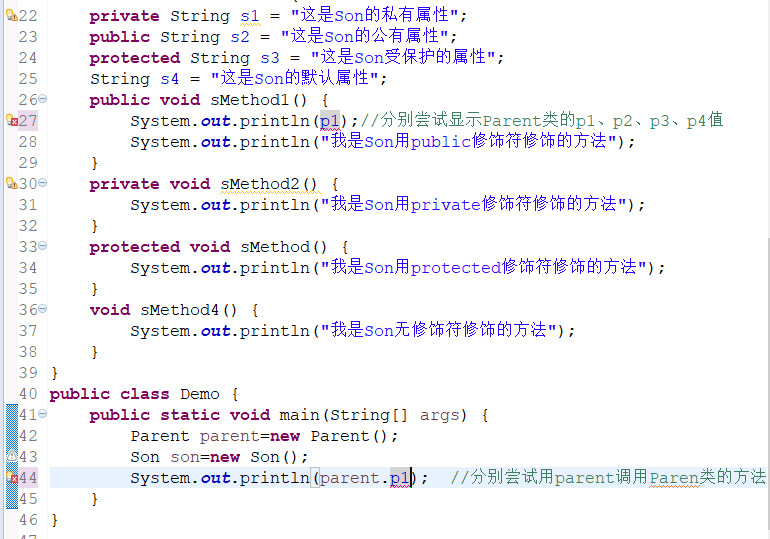
2.

3.
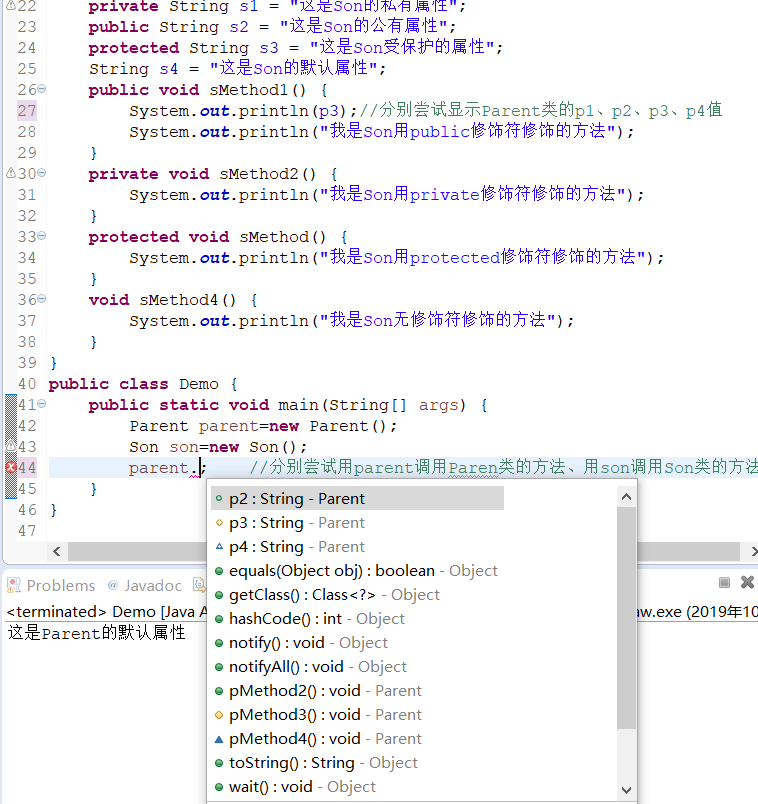
4.
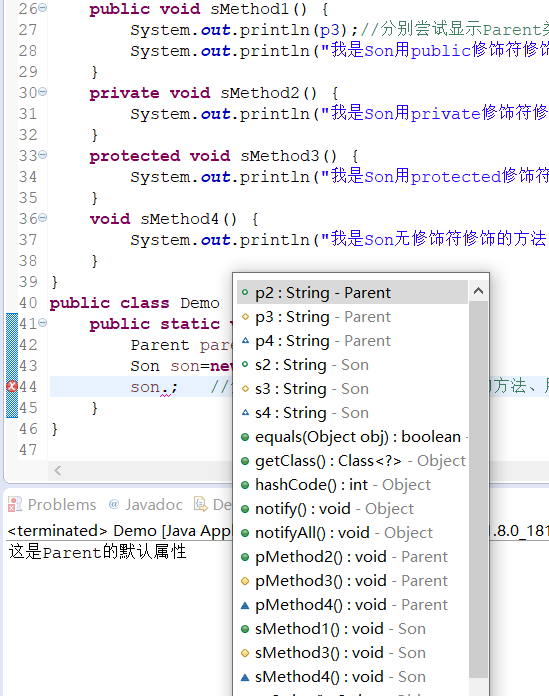
由以上可知,不管方法或属性,只要是private修饰的 ,都只能在本类中用; 子类继承父类的方法与属性。
将子类,父类,主类分开,各建一个类 :

1.子类中调用父类的方法和属性:
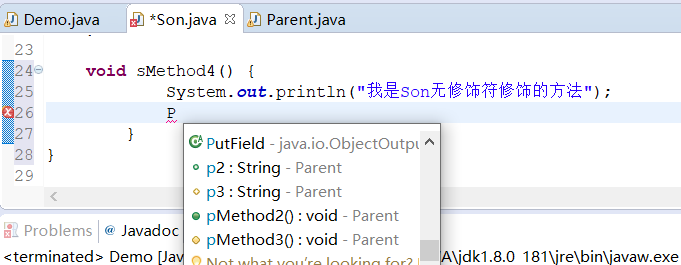
2. 主类中调用Parent类的属性和方法
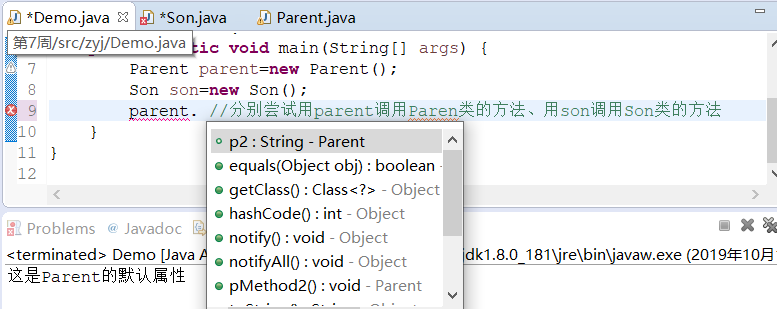
3. 主类中调用Son类的属性和方法
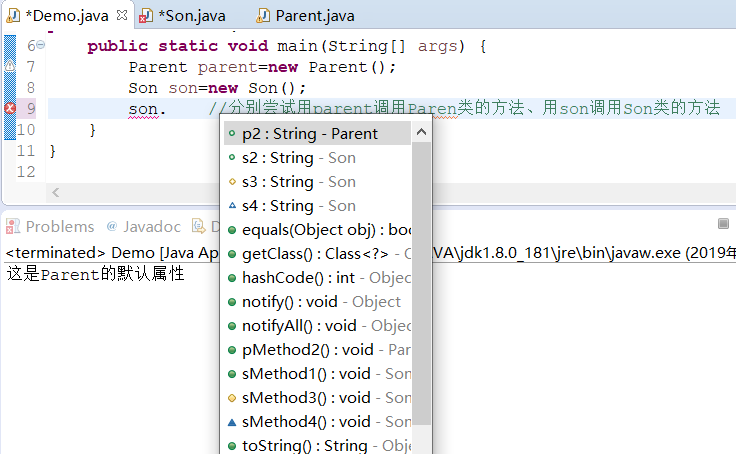
由以上可知: 用public修饰的属性和方法是公用的,用friendly和protected修饰的属性和方法,只有在同一个包中时能访问,特别:protected修饰的,在有继承关系时,可在不同的包中访问。
四种权限修饰符的访问范围:
| 访问范围 | private | friendly(默认) | protected | public |
| 同一个类 | 可以访问 | 可以访问 | 可以访问 | 可以访问 |
| 同一个包内的类 | 不可以访问 | 可以访问 | 可以访问 | 可以访问 |
| 不同包内的类 | 不可以访问 | 不可以访问 | 可以访问 |
可以访问 |
| 不同包并且不是子类 | 不可以访问 | 不可以访问 | 不可以访问 | 可以访问 |
实验2:导入第5章以下示例程序,测试并进行代码注释。
测试程序1:
EqualsTest.java :
1 package equals; 2 3 /** 4 * This program demonstrates the equals method. 5 * @version 1.12 2012-01-26 6 * @author Cay Horstmann 7 */ 8 public class EqualsTest 9 { 10 public static void main(String[] args) 11 { 12 Employee alice1 = new Employee("Alice Adams", 75000, 1987, 12, 15); 13 Employee alice2 = alice1; 14 Employee alice3 = new Employee("Alice Adams", 75000, 1987, 12, 15); 15 Employee bob = new Employee("Bob Brandson", 50000, 1989, 10, 1); 16 17 System.out.println("alice1 == alice2: " + (alice1 == alice2)); 18 19 System.out.println("alice1 == alice3: " + (alice1 == alice3)); 20 21 System.out.println("alice1.equals(alice3): " + alice1.equals(alice3)); 22 23 System.out.println("alice1.equals(bob): " + alice1.equals(bob)); 24 25 System.out.println("bob.toString(): " + bob); 26 27 Manager carl = new Manager("Carl Cracker", 80000, 1987, 12, 15); 28 Manager boss = new Manager("Carl Cracker", 80000, 1987, 12, 15); 29 boss.setBonus(5000); 30 System.out.println("boss.toString(): " + boss); 31 System.out.println("carl.equals(boss): " + carl.equals(boss)); 32 System.out.println("alice1.hashCode(): " + alice1.hashCode()); 33 System.out.println("alice3.hashCode(): " + alice3.hashCode()); 34 System.out.println("bob.hashCode(): " + bob.hashCode()); 35 System.out.println("carl.hashCode(): " + carl.hashCode()); 36 } 37 }
运行结果如下:

Employee.java
1 package equals; 2 3 import java.time.*; 4 import java.util.Objects; 5 6 public class Employee 7 { 8 private String name; 9 private double salary; 10 private LocalDate hireDay; 11 12 public Employee(String name, double salary, int year, int month, int day) 13 { 14 this.name = name; 15 this.salary = salary; 16 hireDay = LocalDate.of(year, month, day); 17 } 18 19 public String getName() 20 { 21 return name; 22 } 23 24 public double getSalary() 25 { 26 return salary; 27 } 28 29 public LocalDate getHireDay() 30 { 31 return hireDay; 32 } 33 34 public void raiseSalary(double byPercent) 35 { 36 double raise = salary * byPercent / 100; 37 salary += raise; 38 } 39 40 public boolean equals(Object otherObject) 41 { 42 // 快速测试,看看这些对象是否相同 43 if (this == otherObject) return true; 44 45 // 如果显示参数为空,则必须返回false 46 if (otherObject == null) return false; 47 48 // 如果类不匹配,它们就不相等 49 if (getClass() != otherObject.getClass()) return false; 50 51 // 现在我们知道 otherObject 是一个非空雇员 52 Employee other = (Employee) otherObject; 53 54 // 测试字段是否具有相同的值 55 return Objects.equals(name, other.name) 56 && salary == other.salary && Objects.equals(hireDay, other.hireDay); 57 } 58 59 public int hashCode() 60 { 61 return Objects.hash(name, salary, hireDay); 62 } 63 64 public String toString() 65 { 66 return getClass().getName() + "[name=" + name + ",salary=" + salary + ",hireDay=" 67 + hireDay + "]"; 68 } 69 }
运行结果如下:

Manager.java
1 package equals; 2 3 public class Manager extends Employee//子类Manager继承父类Employee 4 { 5 private double bonus; 6 7 public Manager(String name, double salary, int year, int month, int day) 8 { 9 super(name, salary, year, month, day); //利用super调用父类构造器 10 bonus = 0; 11 } 12 13 public double getSalary() 14 { 15 double baseSalary = super.getSalary(); 16 return baseSalary + bonus; 17 } 18 19 public void setBonus(double bonus) 20 { 21 this.bonus = bonus; 22 } 23 24 public boolean equals(Object otherObject) 25 { 26 if (!super.equals(otherObject)) return false; 27 Manager other = (Manager) otherObject; 28 // super.equals checked that this and other belong to the same class 29 return bonus == other.bonus; 30 } 31 32 public int hashCode() 33 { 34 return java.util.Objects.hash(super.hashCode(), bonus); 35 } 36 37 public String toString() 38 { 39 return super.toString() + "[bonus=" + bonus + "]"; 40 } 41 }
运行结果如下:

测试程序2:
ArrayListTest.java
1 package arrayList; 2 3 import java.util.*; 4 5 /** 6 * This program demonstrates the ArrayList class. 7 * @version 1.11 2012-01-26 8 * @author Cay Horstmann 9 */ 10 public class ArrayListTest 11 { 12 public static void main(String[] args) 13 { 14 // 用三个Employee 对象填充数组列表 15 ArrayList<Employee> staff = new ArrayList<Employee>(); 16 17 staff.add(new Employee("Carl Cracker", 75000, 1987, 12, 15)); 18 staff.add(new Employee("Harry Hacker", 50000, 1989, 10, 1)); 19 staff.add(new Employee("Tony Tester", 40000, 1990, 3, 15)); 20 21 // 把每个人的薪水提高%5 22 for (Employee e : staff) 23 e.raiseSalary(5); 24 25 // 打印出关于Employee 类的所有信息 26 for (Employee e : staff) 27 System.out.println("name=" + e.getName() + ",salary=" + e.getSalary() + ",hireDay=" 28 + e.getHireDay()); 29 } 30 }
运行结果如下:

测试程序3:
1 package enums; 2 3 import java.util.*; 4 5 /** 6 * This program demonstrates enumerated types. 7 * @version 1.0 2004-05-24 8 * @author Cay Horstmann 9 */ 10 public class EnumTest 11 { 12 public static void main(String[] args) 13 { 14 Scanner in = new Scanner(System.in); 15 System.out.print("Enter a size: (SMALL, MEDIUM, LARGE, EXTRA_LARGE) "); 16 String input = in.next().toUpperCase(); 17 Size size = Enum.valueOf(Size.class, input); 18 System.out.println("size=" + size); 19 System.out.println("abbreviation=" + size.getAbbreviation()); 20 if (size == Size.EXTRA_LARGE) 21 System.out.println("Good job--you paid attention to the _."); 22 } 23 } 24 25 enum Size 26 { 27 SMALL("S"), MEDIUM("M"), LARGE("L"), EXTRA_LARGE("XL"); 28 29 private Size(String abbreviation) { this.abbreviation = abbreviation; } 30 public String getAbbreviation() { return abbreviation; } 31 32 private String abbreviation; 33 }
运行结果如下:


测试程序4:录入以下代码,结合程序运行结果了解方法的可变参数用法
|
public class TestVarArgus { public static void dealArray(int... intArray){ for (int i : intArray) System.out.print(i +" ");
System.out.println(); } public static void main(String args[]){ dealArray(); dealArray(1); dealArray(1, 2, 3); } } |
1. 代码如下:
1 public class TestVarArgus { 2 public static void dealArray(int... intArray)//运用泛型数组列表,传参数,(int... intArray)表示参数的个数是可变的,但都为整型 3 { 4 for (int i : intArray) 5 System.out.print(i +" "); 6 7 System.out.println(); 8 } 9 public static void main(String args[]){ 10 dealArray(); 11 dealArray(1); 12 dealArray(1, 2, 3); 13 } 14 }
运行结果如下:

2. 代码如下:
1 public class TestVarArgus { 2 public static void dealArray(String... stringArray)//运用泛型数组列表,传参数,参数为字符串型 3 { 4 for (String i : stringArray) 5 System.out.print(i +" "); 6 7 System.out.println(); 8 } 9 public static void main(String args[]){ 10 dealArray("friend"); 11 dealArray("zhang qi" ); 12 dealArray("wang xue","qi xue"); 13 } 14 }
运行结果如下:

实验:3:编程练习:参照输出样例补全程序,使程序输出结果与输出样例一致。
|
程序运行结果如下: Parent's Constructor with a boolean parameter Son's Constructor without parameter Son's method() Parent's method() |
代码如下:
1 package zyj; 2 3 public class Demo { 4 public static void main(String[] args) { 5 Son son = new Son(); 6 son.method(); 7 } 8 } 9 class Parent { 10 Parent() { 11 System.out.println("Parent's Constructor without parameter"); 12 } 13 Parent(boolean b) { 14 System.out.println("Parent's Constructor with a boolean parameter"); 15 } 16 public void method() { 17 System.out.println("Parent's method()"); 18 } 19 } 20 class Son extends Parent { 21 //补全本类定义 22 Son(){ 23 super(false); 24 System.out.println("Son's Constructor without parameter"); 25 } 26 public void method() { 27 System.out.println("Son's method()"); 28 super.method(); 29 } 30 }
运行结果如下:

实验总结:在本次实验中,验证了四种权限修饰符的范围,private只能在自身的类中访问,protected在同一包不同类中能访问,但是在不同包中不能访问,(有继承关系但在不同的包中的两个类可以访问), public是在不同的包和不同的类都可以访问,默认修饰符(friendly)在同一包不同类中可以访问,不同包中不能访问。以及泛型数组列表的学习,其中传的参数是可变的,注意的是参数的类型; 还有枚举类的学习。




